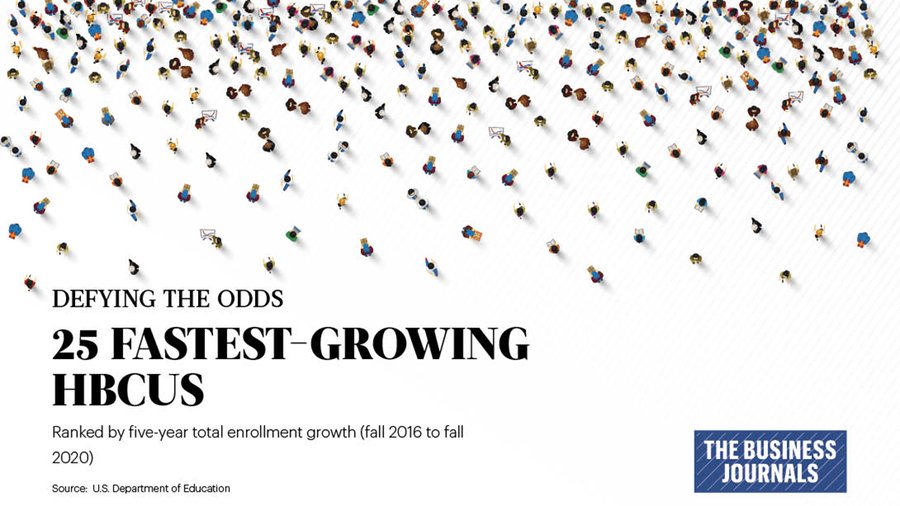While historically Black colleges and universities have collectively lost enrollment in the last five years, 33 schools have posted gains during that period.
HBCU enrollment fell 4.5% between fall 2016 and fall 2020 to 279,157 total students, with institutions reporting an average enrollment decline of .1%. Fifty-one schools posted double-digit declines during that period while 19 schools reported enrollment gains over 10%, according to a Business Journals analysis of the most recent data available from the U.S. Department of Education. For comparison, total enrollment at 1,600 U.S. colleges and universities grew 1.7% in the past five years.
As a sector, HBCUs include 101 historically Black, accredited colleges and universities established prior to 1964 with principal missions to educate Black Americans, according to the Higher Education Act of 1965. These schools educated Black Americans during legal segregation when Black students were generally denied admission to white institutions, and today they "still represent a vital component of American higher education," according to the U.S. Department of Education.
Central State University, a public school in Wilberforce, Ohio, grew the fastest of all HBCUs in the past five years, reporting total enrollment growth of 131% between fall 2016 and fall 2020. Central State doubled its enrollment between fall 2019 and fall 2020 to 4,021 students. Enrollment again grew this fall to over 6,000 students, Harold Dixon, the university’s dean of enrollment management, said in a recent interview. Dixon told The Business Journals that the addition of an honors college, an online MBA and five online undergrad programs have all helped boost enrollment.
Rounding out the top five fastest-growing historically Black universities are Albany State University in Georgia (114% growth); Talladega College in Alabama (71% growth); Southern University Law Center in Baton Rouge, Louisiana (50% growth); and Elizabeth City State University in North Carolina (48% growth).
For its part, Albany State credited its 6.3% enrollment growth during the pandemic from fall 2019 to fall 2020 to scholarship allocations, recruitment strategies and student success programs, including virtual peer tutoring.
“Students and parents continue to be impressed by our range of over 60 programs and our continued commitment to academic excellence and student success,” said vice president of enrollment management and student success Kenyatta Johnson in a 2020 release. “The student success initiatives we have launched in the past year have assisted with retention and improved upon the collegiate experience.”
North Carolina Agricultural and Technical State University in Greensboro, which reported five-year enrollment growth of 14%, told The Business Journals that it aspires to enroll 14,000 students by 2023. The university reported 12,753 total students last fall and 13,322 students this fall, making it the largest HBCU in the U.S.
“North Carolina A&T has made significant investments in student success by keeping access and equity at the forefront of our decisions,” said Jacqueline Powers, N.C. A&T associate vice provost for enrollment management. “This fall the university made a commitment to all students with the implementation of our free textbook program, emergency funds, merit scholarships, and summer funding support. These strategic investments are just an example of factors that contribute to our enrollment growth.”
Powers added that the university has also strengthened relationships with businesses, industry and community colleges to attract more transfer students and adult learners.
Want more higher-education news? Sign up for The National Observer: Higher Education Edition here.











